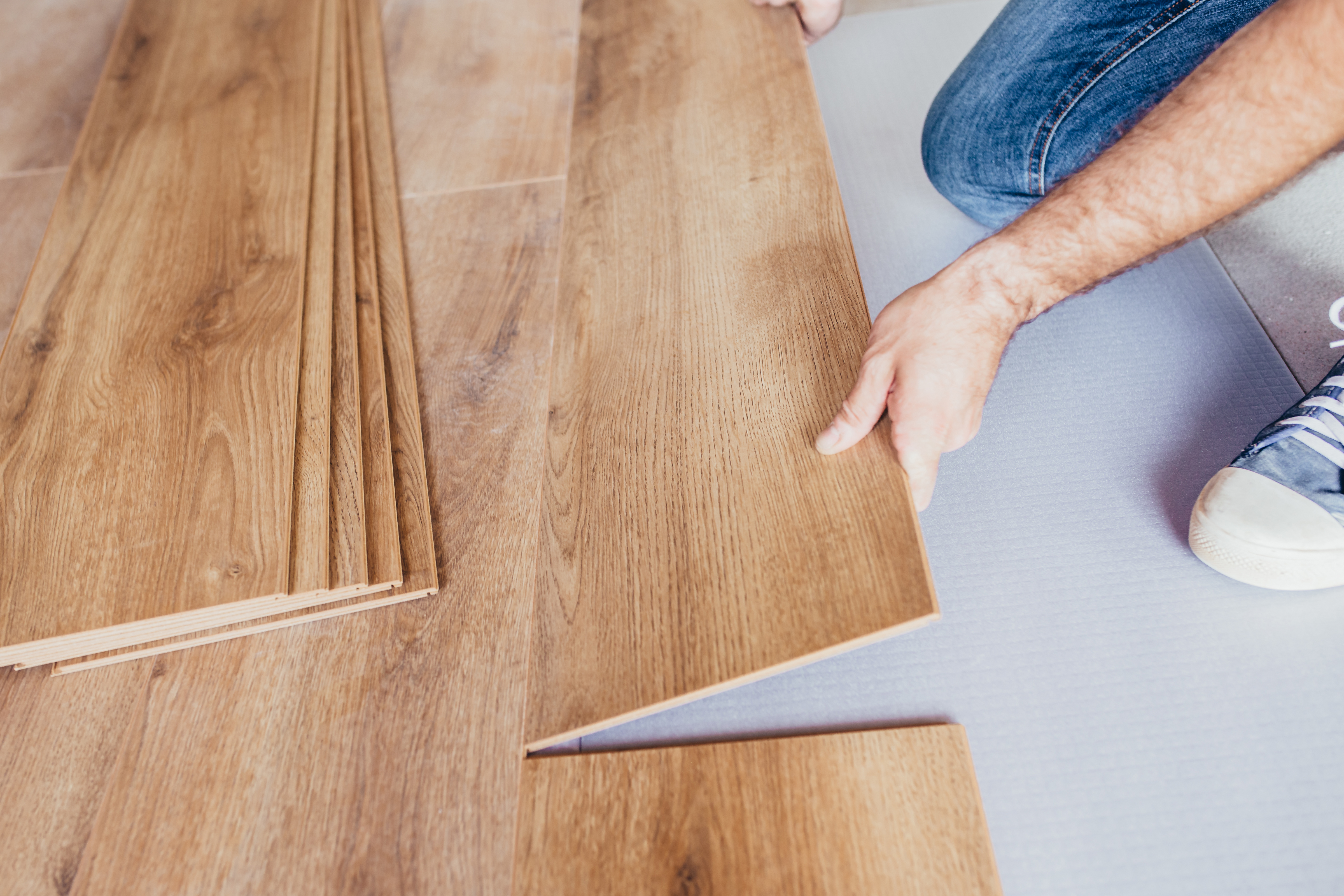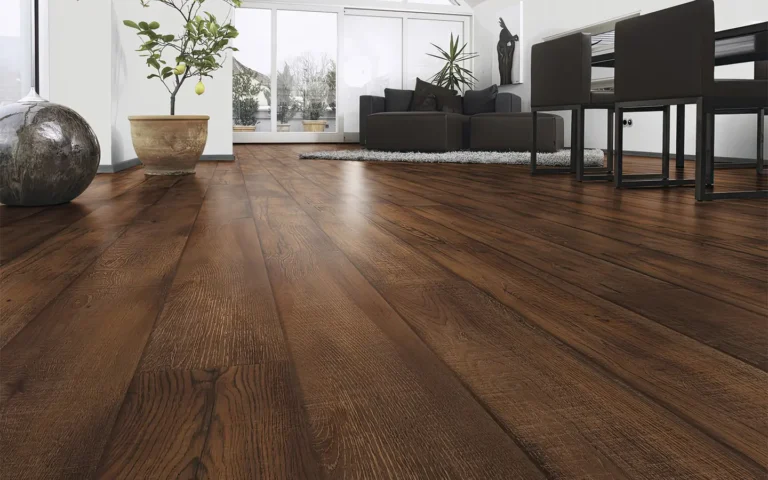This post may contain references or links to products from one or more partners of our parent company and/or subsidiaries of our parent company. For more information, visit this page.
December 4, 2020
If you’ve ever found yourself wondering “what is a floating floor?” You’re in the right place! This method of floor installation is great for DIY-ers and professionals alike.
Why? Floating floors are easy (and often cheaper) to install. They’re common with all types of flooring materials. They can even help to create environmentally friendly floors because they avoid harmful adhesives. And they have a ton of other benefits we’ll talk about further down.
So: keep reading for the answer to the “what is a floating floor” question. Plus, we’ll explain what types of flooring can be installed as floating floors, the advantages and disadvantages of this type of installation, and much more.
By the end, you’ll know whether floating floors are right for you!
First of All: What is a Floating Floor?
So, what is a floating floor, exactly?
First and foremost, the term “floating floor” refers to an installation style rather than a specific product. In other words, almost any type of flooring material can be installed as a floating floor, with a few exceptions.
Now, you might be inclined to think that floating floors literally float. But as cool as that would be, floating floors simply rest atop your subflooring. There’s no need to nail or glue them down.
How Are Floating Floors Held in Place?
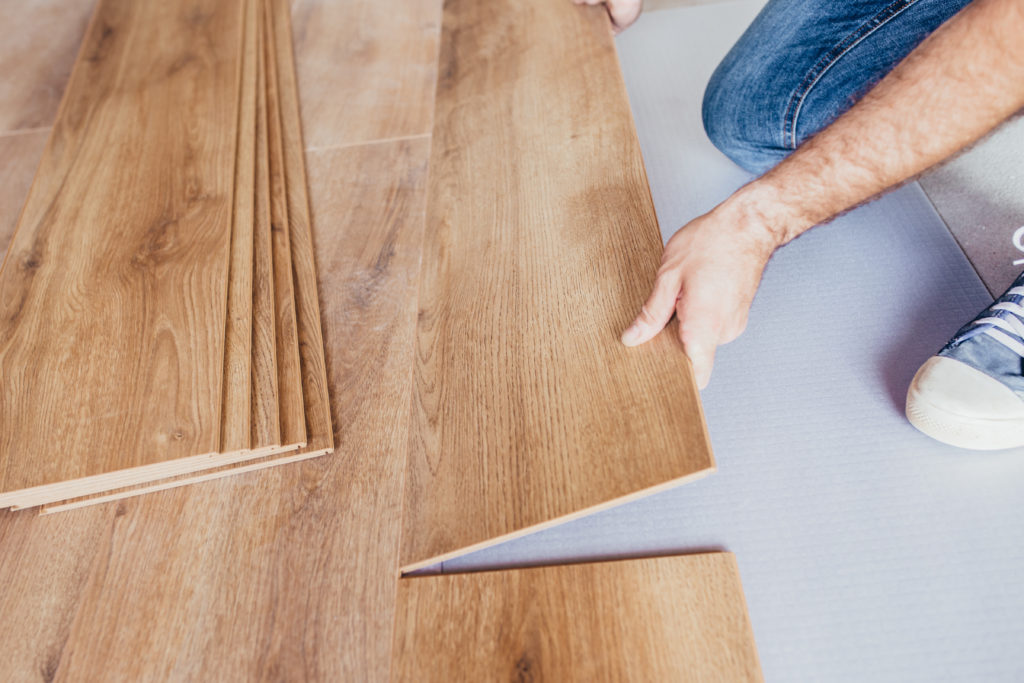
You can glue floating floors down. But most of the time, they’re held down by the all-powerful forces of friction and gravity.
Basically, to understand what a floating floor is, you need to understand click-together flooring. Click-together or “snap-lock” floor planks are attached to each other via tightly-fitting interlocking grooves or rivets. Think of them like a high-tech jigsaw puzzle.
When an entire floor of click-together planks is snapped together, the weight of the resulting surface—plus the friction of the connections—keeps the floor in place.
And voila! It “floats” above the subfloor.
This makes floating floors some of the easiest floors to install because you can simply snap them together.
And of course, if you do happen to make a mistake, there’s no need to rip out nails or staples in frustration. Just unsnap them and try again!
Floating Floors vs. Non-Floating Floors: What Are the Differences?
Since many types of flooring come in both floating and non-floating varieties, the only big difference is how they’re installed.
- Nail-down floors are (gasp!) nailed to a subfloor or underlayment. And while that might give them some advantages, they are harder to install and remove.
- Staple-down floors are put in similarly, but are usually reserved for lighter floors like vinyl or soft(er) hardwoods.
- Glue-down floors use adhesives (sometimes containing harmful chemicals) to attach the floor to the subflooring.
So to recap: what is a floating floor? It’s a style of floor installation that doesn’t rely on a fastener (glue, nails, etc.) to attach it to the subfloor. Only gravity and friction!
Best Brands of 2024
What Types of Flooring Can Be Installed As Floating Floors?
Most types of flooring can be installed as floating floors. Again, “floating floor” simply refers to the installation style.
For example, many types of wood flooring can be installed as this way, though it’s important to note that the majority of these options are engineered. (Remember that!)
Alternatively, laminate, luxury vinyl plank, and even tile are available as floating floors as well.
Engineered Hardwood
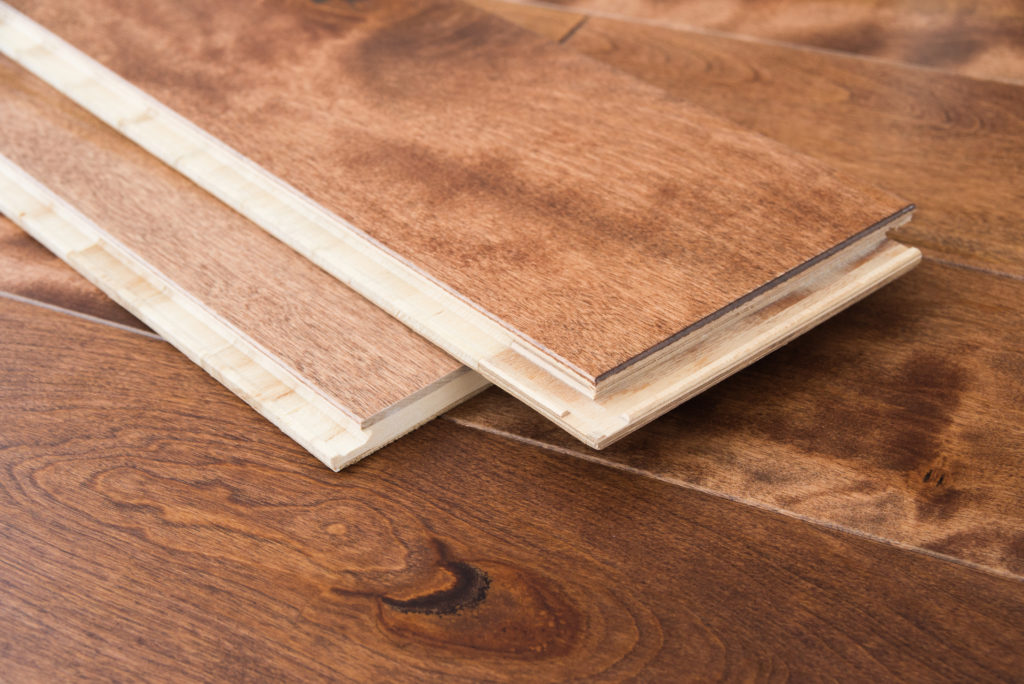
Solid hardwood may be the only floor type that’s not commonly sold in a floating style (more on that later). But one of the best solid wood floor alternatives—engineered hardwood—is often installed as a floating floor.
Engineered wood is real hardwood. The only difference is that while solid wood is made of one solid plank throughout, engineered wood is made of a thin veneer of solid wood bonded to a super-strong plywood core. That’s about all there is to it!
Are there some engineered wood disadvantages? Sure, but none of them relate to installation. Plus, engineered wood has many other advantages over solid.
And one of those advantages is that the cost to install engineered hardwood floors is generally cheaper than the cost to install solid wood floors. That’s because a huge number of the best engineered wood flooring products can be installed as floating floors. And floating floors are cheaper to install in general!
Laminate
If you love the idea of fake wood flooring, laminate can almost always be installed as a floating floor.
What is laminate flooring? It’s a composite floor that’s often made of three layers. From the bottom, they are:
- A core layer, usually made of fiberboard or plywood, which gives the flooring its base.
- A design layer that offers a photorealistic image of whatever the floor is imitating (like real wood or stone).
- And a wear layer that acts as a shield for the underlying layers.
There are even waterproof laminate options these days like Mohawk’s RevWood, which relies on its click-together fasteners to create a watertight seal. And if you’re nervous about the phrase “composite floor”, don’t be—non-toxic laminate flooring is relatively common!
Luxury Vinyl Plank
Luxury vinyl plank, or LVP, is another good floating option. In fact, almost all LVP products can be floated. (Quick note: “LVT” or “luxury vinyl tile” is essentially the same thing as LVP).
If you look into the differences between vinyl plank vs. laminate, you’ll find that they have a similar design structure. LVP is just composed primarily of vinyl instead of multiple materials.
This makes LVP a better option for hard-wearing applications like mudroom flooring because it tends to be a little more robust. And while there are some vinyl plank flooring disadvantages, it is almost always waterproof—thanks, in no small part, to its click-together floating installation!
If LVP sounds like a good fit for you, check out some Pergo Extreme reviews—Pergo Extreme is one of the most popular vinyl plank options on the market.
Tile
Tile is one of the oldest types of flooring in the world. And perhaps as a result, there are tons of types of floor tiles to choose from.
Unfortunately, tile is also one of the hardest (and most expensive) types of flooring to install. In fact, a shortage of qualified tile installers is one of the biggest issues facing the flooring industry today.
To address this, tile manufacturers have created a solution: snap-together tile flooring. That’s right—you can now install floating floors made of real porcelain tile!
Previously, buyers comparing tile vs. laminate often went with the latter because tile is so expensive to install. But not anymore!
Snap-together tiles are a great option for bathrooms and kitchens, or anywhere spills might be common. They’re easy to install and come in a variety of colors and designs. Wood-look tile, for instance, is a great alternative to hardwood flooring for areas that are prone to moisture.
Carpet Tiles (Sort Of)
Okay, we might be bending the definition of what qualifies as a floating floor here, but peel-and-stick carpet tiles basically act like a floating floor system. You don’t have to staple them down, and while there is a “gluing element”, they’re still easy to remove and DIY friendly.
So, you could say carpet tiles capture the spirit of floating floors—after all, what is a floating floor if not a cheaper and easier installation method?
Anyway, carpet’s best perk is that it’s probably the comfiest flooring you can get. In the debate between carpet or hardwood in the bedroom, many people continue to choose carpet solely because it won’t freeze their feet off in winter.
Carpet similarly wins the carpet vs. laminate when it comes to comfort. And rest easy, earth warriors—there are numerous low-VOC carpet choices available for people who are sensitive to chemicals!
How Long Do Floating Floors Last?
Hint: it depends on the type!
There are lots of elements to discuss when answering the “what is a floating floor” question. But it’s important to remember that floating floors are a style of installation. So, the lifespan of a floating floor depends almost entirely on the material it’s made of.
The only element to note here is that floating floors can be more prone to wearing down (compared to traditionally-installed floors) if they’re installed over an uneven, unsuitable, or damaged underlayment. But if installed correctly, that’s not a problem!
Floating Floor Advantages
A floating floor’s chief advantage centers around its ease of installation. However, there are plenty of other advantages too!
Floating Floors Are Often Cheaper to Install
Floating floors are often cheaper to install than non-floating floors because they’re less time- and labor-intensive to put in.
Virtually anyone that’s physically able to do so (and who understands the basic premise of Legos) can install a floating floor.
Plus, if you do hire labor, there’s a good chance that your contractors will finish the job quicker—and quicker usually means cheaper!
Nails and glue can get pretty pricey, too. Home Depot sells flooring nails for anywhere from $5 to $8 per pound. Oh, and “floor glue” goes for about $30/gallon (though in fairness, prices vary widely).
Considering that traditional floors need those nails or staples, hardwood floor alternatives like floating laminate are much more economical.
Similarly, if you compare the cost to replace carpet with solid hardwood to the cost to replace carpet with floating engineered wood, you’re much more likely to save with the latter.
Installing Floating Floors Is Super Easy
What is a floating floor’s greatest strength? We’ve touched on this aspect a lot, but again—ease of installation is probably the biggest draw.
The hardest part about installing floating floors is making sure that each sheet or plank is properly connected to its counterpart. That’s basically it.
For comparison, one of the biggest disadvantages of hickory flooring—or almost any super-hard wood for that matter—is that it can be tough to install in solid planks. Floating hickory floors, however, just need to be laid down and clicked together.
At worst, some people like to glue select planks or sheets for extra security. But that’s nothing compared to gluing or nailing down hundreds or even thousands of square feet of non-floating flooring.
Floating Floor Maintenance Is Usually Minimal
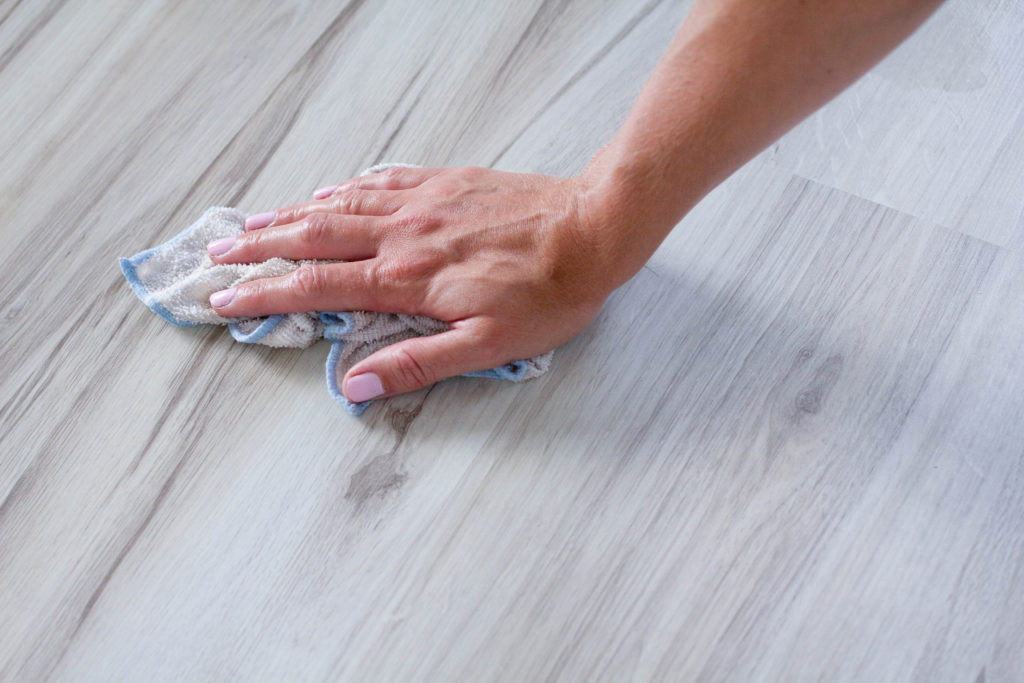
Okay, it’s very important to understand that when we say “floating floor maintenance,” we’re referring to maintenance you would specifically perform on floating floors.
In other words, you’ll still have to do whatever maintenance the material of your floor requires (i.e. vinyl needs a good scrubbing). Your floating floors won’t magically make your vinyl or laminate floors dirtproof.
What we mean is that there’s no special maintenance required for floating floors. Whatever you would do for traditionally-installed floors is what you would do for the floating version.
Floating Floors Are More Convenient to Replace
Since floating floors are pretty easy to remove, they’re equally easy to replace!
Simply (and properly!) dispose of your old floors and then throw down your new floors. Forget the glue stripper, nail removers, or power tools—you can just use your hands and a multitool.
Heck, you could even replace your old floating floors with new floating floors!
Almost Any Material Can Be Installed as a Floating Floor
Whether you want regal wood floor patterns, a single-color design, or a unique vinyl plank design, there’s a good chance it can be installed as a floating floor.
If you want jet black ebony floors, there’s a decent chance that someone out there makes a floating version (though it’s more likely to be ebony-stained wood as real ebony is exceedingly rare). Or, instead of dark ebony, go with light ash flooring.
Want to experience the pros and cons of bamboo flooring for yourself? Why not try it as a floating floor? The amount of options is head spinning!
Floating Floors Can Be More Eco-Friendly (No VOCs)
Remember how we said you don’t need to use glue to secure your floating floors? Well, many flooring adhesives are known to contain harmful chemicals known as volatile organic compounds, or VOCs.
VOCs are harmful to people, pets, and the environment. By going the floating floor route, you’re making a more eco-friendly flooring choice.
Now, some wood products still use harmful chemicals in their construction, so it can be hard to avoid dangerous chemicals altogether. And laminate and vinyl planks can also be of questionable friendliness towards the environment.
But, there are plenty of low-VOC flooring choices available—even low-VOC vinyl flooring. And if green living is important to you, you can always go with sustainable wood flooring that a) avoids adhesives and b) uses an eco-friendly finish.
Floating Floors Make Swapping Your Flooring Easy
Let’s say you’ve looked into teak flooring pros and cons and have decided it’s the floor for you.
But you also know that, in a couple of years, you might be getting a dog or having a child. And you know that teak won’t stand up to dings and dents like vinyl, laminate, or another hardwood floor alternative will. What do you do?
Install your teak as a floating floor! You can enjoy it for the time being and, when you’re ready to swap it out, it’s just a matter of paying for the labor (or doing it yourself). No ripping up nails, no destroying your beautiful teak trying to strip adhesives. Store it for the future or re-use it elsewhere!
Floating Floor Disadvantages
Alright, alright—to be fair, we have to talk about the disadvantages of floating floors too. Floating floors aren’t perfect, and with the good comes the bad.
Floating Floors May Have a Hollow Sound or Be Noisy
What is a floating floor’s greatest weakness? Possibly the noise.
A lot of factors go into the noise a floor produces: the type and thickness of its material, its underlayment, and so on.
Because floating floors can be thinner than, say, solid hardwood floors, they can be noisy. Some buyers complain of a “hollow sound” not unlike the sound of banging on thin drywall.
But there are 2 pieces of good news here:
- Almost all noise issues can be remedied by installing your floating floors over the appropriate underlayment.
- Many companies make products that have built-in underlayments to account for noise issues.
Floating Floors Need a Good, Solid Subfloor
What is subflooring? Well, it’s what goes under your floors! You could probably think of your subflooring as part of the bones of your house.
Anyway, since some floating floors like flexible LVT are relatively thin, a lot of their rigidity comes from your subflooring. So if your subflooring isn’t optimal, you may be in for warped or bent floors.
Of course, virtually all flooring needs quality subflooring, so this isn’t that out of the norm. But if you install floating floors atop shoddy subflooring, the issues may be more pronounced.
Floating Floors Can Feel Less Sturdy
Continuing from the last section, some buyers complain that their floating floors just don’t feel as sturdy as traditionally-installed floors.
Again, this goes back to the issue of subflooring and underlayments. If your subfloor and underlayment are secure and even, there’s almost no reason to worry in this regard.
Our advice: ask your local flooring store about this—almost all floating floor manufacturers have recommended underlayments for their specific products!
Floating Floors May Offer Less Resale Value
What is a floating floor’s other greatest perceived disadvantage? That it may offer less resale value than a traditionally-installed floor. But there are a ton of technicalities here (and there’s no real evidence that it’s true), so take it with a grain of salt.
In fact, the value difference between floating and non-floating floors usually just comes down to the difference between types of flooring. For example, solid hardwood may be more valuable than LVP, but not because the LVP was installed as a floating floor.
Floating Floors Made of Solid Hardwood Are Harder to Find
We’ve mentioned this a few times already, but it is harder to find solid wood that installs as a floating floor.
That’s not to say it’s impossible—some of the best hardwood floor brands might sell solid wood floating floors—but finding these options may take some digging.
Still, if you’re searching for the most durable wood floors available, engineered hardwood can be just as good (if not better) than solid. Plenty of engineered products can be installed as floating floors, and you can find almost any hardwood species as an engineered product.
Top Brands of Floating Floors
What are the top brands of floating floors? Pretty much the same brands that offer non-floating floors!
Shaw, Mohawk, Mannington—name a company and there’s a good chance they make floating floors.
If engineered wood is your thing, virtually all the best engineered wood flooring brands sell floating floors (as do LVP and laminate producers).
So: What is a Floating Floor, and Is a Floating Floor Right for You?
Hopefully, this article has answered the “what is a floating floor” question and given you all the information you need to decide whether a floating floor is right for you!
Now, the only thing left to do is start looking at specific types of flooring. We would recommend finding a top-rated flooring store in your area for that purpose. Local flooring retailers are super knowledgeable and can help you find the perfect floors for you. Big box store clerks…not so much.
And if you want more info on different types of flooring, be sure to check out:
- Pine Flooring: The Pros and Cons
- Douglas Fir Flooring Pros and Cons
- Hickory Flooring Pros and Cons: The Guide
- Advantages & Disadvantages of Cork Flooring
- Is the Cork Flooring Lowes Sells Actually Worth Buying?
- Can You Refinish Bamboo Flooring? Here’s How
- Hemp Flooring: Your Complete Guide to Hemp Wood
About The Author

Christian Southards
December 4, 2020
Christian is a freelance everything-writer, editor, and interior design nerd. When he’s not writing about flooring and remodeling, he’s either writing news for the California American Legion or working with his hands on his house. His favorite type of flooring is hardwood, but admits to having carpet in his bedroom.
